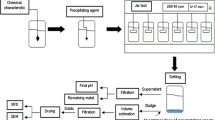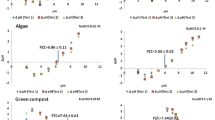Abstract
In the present study, a response surface methodology was used to optimize the electroleaching of Mn from low-grade pyrolusite. Ferrous sulfate heptahydrate was used in this reaction as a reducing agent in sulfuric acid solutions. The effect of six process variables, including the mass ratio of ferrous sulfate heptahydrate to pyrolusite, mass ratio of sulfuric acid to pyrolusite, liquid-to-solid ratio, current density, leaching temperature, and leaching time, as well as their binary interactions, were modeled. The results revealed that the order of these factors with respect to their effects on the leaching efficiency were mass ratio of ferrous sulfate heptahydrate to pyrolusite > leaching time > mass ratio of sulfuric acid to pyrolusite > liquid-to-solid ratio > leaching temperature > current density. The optimum conditions were as follows: 1.10:1 mass ratio of ferrous sulfate heptahydrate to pyrolusite, 0.9:1 mass ratio of sulfuric acid to pyrolusite, liquid-to-solid ratio of 0.7:1, current density of 947 A/m2, leaching time of 180 min, and leaching temperature of 73°C. Under these conditions, the predicted leaching efficiency for Mn was 94.1%; the obtained experimental result was 95.7%, which confirmed the validity of the model.
Similar content being viewed by others
References
W.S. Zhang and C.Y. Cheng, Manganese metallurgy review. Part I: Leaching of ores/secondary materials and recovery of electrolytic/chemical manganese dioxide, Hydrometallurgy, 89(2007), No. 3–4, p. 137.
S.C. Das, P.K. Sahoo, and P.K. Rao, Extraction of manganese from low-grade manganese ores by FeSO4 leaching, Hydrometallurgy, 8(1982), No. 1, p. 35.
C. Abbruzzese, M.Y. Duarte, B. Paponetti, and L. Toro, Biological and chemical processing of low-grade manganese ores, Miner. Eng., 3(1990), No. 3–4, p. 307.
A. Ekmekyapar, C. Asin, N. Demirkiran, A. Künkül, A. Baysar, and K. Ceylan, Reductive leaching of pyrolusite ore by using sawdust for production of manganese sulfate, Russ. J. Non-Ferrous. Met., 53(2012), No. 3, p. 211.
F.F. Wu, H. Zhong, S. Wang, and S.F. Lai, Kinetics of reductive leaching of manganese oxide ore using cellulose as reductant, J. Cent. South Univ., 21(2014), No. 5, p. 1763.
J.J. Song, G.C. Zhu, P. Zhang, and Y.N. Zhao, Reduction of low-grade manganese oxide ore by biomass roasting, Acta Metall. Sin. Engl. Lett., 23(2010), No. 3, p. 223.
A.A. Ismail, E.A. Ali, I.A. Ibrahim, and M.S. Ahmed, A comparative study on acid leaching of low grade manganese ore using some industrial wastes as reductants, Can. J. Chem. Eng., 82(2004), No. 6, p. 1296.
C. Acharya, R.N. Kar, and L.B. Sukla, Studies on reaction mechanism of bioleaching of manganese ore, Miner. Eng., 16(2003), No. 10, p. 1027.
Y.F. Han, X.M. Ma, W. Zhao, Y.K. Chang, X.X. Zhang, X.B. Wang, J.J. Wang, and Z.Y. Huang, Sulfur-oxidizing bacteria dominate the microbial diversity shift during the pyrite and low-grade pyrolusite bioleaching process, J. Biosci. Bioeng., 116(2013), No. 4, p. 465.
A.E. Elsherief, A study of the electroleaching of manganese ore, Hydrometallurgy, 55(2000), No. 3, p. 311.
M.A. Bezerra, R.E. Santelli, E.P. Oliveira, L.S. Villar, and L.A. Escaleira, Response surface methodology (RSM) as a tool for optimization in analytical chemistry, Talanta, 76(2008), No. 5, p. 965.
R.L. Mason, R.F. Gunst, and J.L. Hess, Statistical Design and Analysis of Experiments: with Applications to Engineering and Science, 2nd Ed, John Wiley & Sons Incorporation, New Jersey, 2003, p. 728.
M.D. Turan and H.S. Altundogan, Leaching of copper from chalcopyrite concentrate by using ammonium persulphate in an autoclave: determination of most suitable impeller type by using response surface methodology, J. Cent. South Univ., 20(2013), No. 3, p. 622.
G.B. Liang, J.H. Tang, W.P. Liu, and Q.F. Zhou, Optimizing mixed culture of two acidophiles to improve copper recovery from printed circuit boards (PCBs), J. Hazard. Mater., 250–251(2013), p. 238.
A.K. Das, V. Mandal, and S.C. Mandal, Design of experiment approach for the process optimisation of microwave assisted extraction of lupeol from ficus racemosa leaves using response surface methodology, Phytochem. Anal., 24(2013), No. 3, p. 230.
M. Vaez, A.Z. Moghaddam, and S. Alijani, Optimization and modeling of photocatalytic degradation of azo dye using a response surface methodology (RSM) based on the central composite design with immobilized titania nanoparticles, Ind. Eng. Chem. Res., 51(2012), No. 11, p. 4199.
X.Y. Guo, D. Li, Z. Wu, and Q.H. Tian, Application of response surface methodology in optimizaing the sulfation-roasting-leaching process of nickel laterite, Int. J. Miner. Metall. Mater., 19(2012), No. 3, p. 199.
C. Iborra-Bernad, P. García-Segovia, and J. Martínez-Monzó, Effect of vacuum cooking treatment on physicochemical and structural characteristics of purple-flesh potato, Int. J. Food Sci. Technol., 49(2014), No. 4, p. 943.
A. Shemi, S. Ndlovu, V. Sibanda, and L.D. van Dyk, Extraction of aluminium from coal fly ash: identification and optimization of influential factors using statistical design of experiments, Int. J. Miner. Process., 127(2014), p. 10.
A. Lambert, P. Drogui, R. Daghrir, F. Zaviska, and M. Benzaazoua, Removal of copper in leachate from mining residues using electrochemical technology, J. Environ. Manage., 133(2014), p. 78.
D.C. Montgomery, Design and Analysis of Experiments, 6th Ed, John Wiley & Sons Incorporation, New York, 2007, p. 405.
T.P. Ryan, Modern Engineering Statistics, John Wiley & Sons Incorporation, Hoboken, New Jersey, 2007, p. 382.
H. Arellano-Garcia, J. Schoneberger, and S. Korkel, Optimal design of experiments in the chemical engineering, Chem. Ing. Tech., 79(2007), No. 10, p. 1625.
Author information
Authors and Affiliations
Corresponding author
Rights and permissions
About this article
Cite this article
Zhang, Xr., Liu, Zh., Fan, X. et al. Optimization of reaction conditions for the electroleaching of manganese from low-grade pyrolusite. Int J Miner Metall Mater 22, 1121–1130 (2015). https://doi.org/10.1007/s12613-015-1176-x
Received:
Revised:
Accepted:
Published:
Issue Date:
DOI: https://doi.org/10.1007/s12613-015-1176-x




